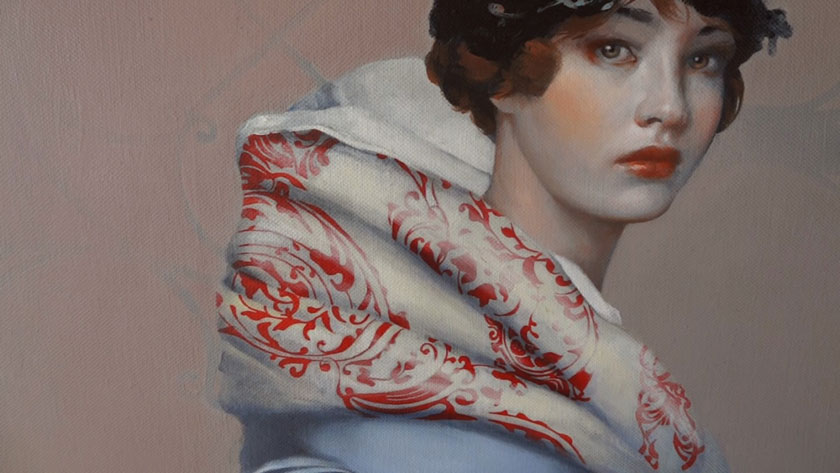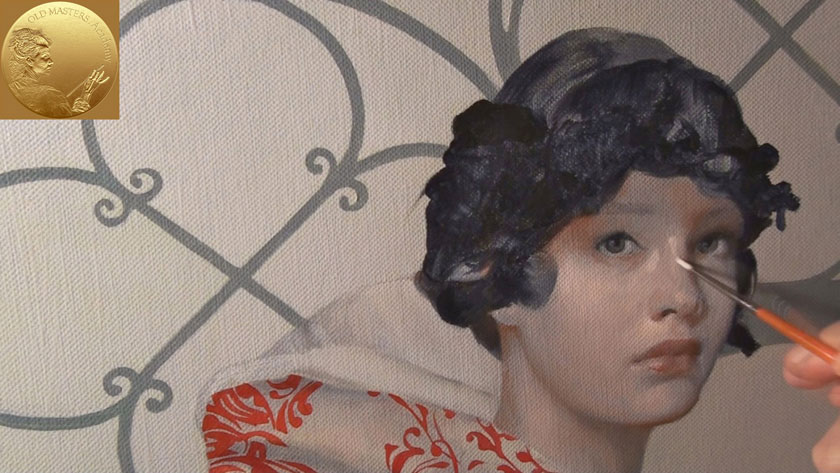Art Lesson 43, Part 3
Discover How to Paint a Girl Portrait
Learn how to paint like the Old Masters!
Old Masters Academy Online Course
Self-study, self-paced online video courseLifetime membershipOne-time payment: $487Enroll Now!Personal Tutoring online + Online Course
Unlimited tutoring by the Academy teachersLifetime membershipOne-time payment: $997Enroll Now!« Back to the Art Lessons List
Portrait Painting Over Dead Layers – Grisaille

While you were working on dead colors you were in total control of the shape of the face, and you were concentrating on light and shadows only. Now it’s time to give some color to the painting. Before applying a new layer of paint make sure that previous layers are dry. How dry should the lower layers be? There are a few categories of dryness. If the surface is covered with seemingly dry film but your fingers are sticking when you touch it with a little bit of pressure – wait longer until the surface is dry to the touch. This way your work will be protected against mixing paint from lower layers with the upper layers. Now the advantages of painting on a dry “dead color” surface become obvious – you can apply a thick or thin cover of oil paint; and the results would be different for each. Try to keep under-layers showing through the new layers, this will give an optical mix of colors, which is not achievable by simply mixing the paint.
In places where you would like to make cold nuances in colors, for example, under the cheekbone, you could increase transparency of the paint layer by spreading paint thinly. Use a dry soft brush to spread a tiny amount of paint, leaving blue “dead color” shining through.
To smooth out sharp details of the portrait and soften shadows you can use Titanium White mixed with tiny amounts of Burnt Sienna and Naples Yellow.
By increasing the amount of Burnt Sienna in the mix you can achieve a very pleasant warm brown tint. This tint can be used for creating the illusion of a 3D effect for shadows and semi-shadows. The tint will also introduce nice nuances to the skin. To give the portrait an impressionistic, mysterious mood you can apply a smart trick – make all lights cold, but make shadows cold in some places, warm in other places. The “dead layers” play a crucial role here – beautiful gradations between cold and warm colors make the picture more attractive to the eye. Despite the variety of tones used, the portrait would retain cold face tones and warm shadows.

While painting the chin, pay attention to how smooth and round it is. Try to depict its shape by gradual changes of the tone.
The face is lit with natural diffused light, and it also shows cast shadows. To portray such illumination you could use two types of brushes. One is for applying relatively thick layers of paint; another type of brush is for spreading paint thinly. The second type of brush, usually round, takes relatively little paint. It allows you to stroke the canvas accurately and lightly, achieving delicate hints of colors. The advantage of thin layer painting is the precise control over the shade effects, which only can be achieved by the optical transparency of multiple layers. Mixing oil paints directly on the palette would not result in such subtle nuances and rich atmospheric effects. Do not confuse this technique with “scumbling,” which will be discussed in another video lesson.

The same color mix can be enhanced by adding a bit more Burnt Sienna and a tiny amount of opaque Caput Mortuum. Caput Mortuum pigment, also known as English Red, is very strong and can dominate in any mixture. Use it carefully.
For highlighting the shapes and adding volume to the paint layer add Titanium White to the mix. Titanium White is an opaque, solid pigment which is suitable for thick, textured layers.

Keep the mixture of your colors as simple as possible. Blending many types of pigments together could result in chemical instability. Paintings with such mixtures may start to develop color alterations immediately and will experience increased colour changes in years to come. Knowing all the risks, you can avoid undesirable consequences. One of the most important rules of oil painting is to keep the number of paints in the mix limited to avoid any surprises.
The face is starting to get its natural colors. You have much greater control over the colors with the help of under-laying tints showing through semi-translucent top layers. The three-dimensional illusion of the face shapes is becoming more obvious. Colors are helping to emphasize lights and shadows.
Choose extra fine round brushes to paint very delicate and subtle details.
To make the model’s eyebrows look natural, put down the paint in a particular place and then spread it evenly, until borders of the eyebrow disappear. Use a cold, dark blue mix of colors, which creates the typical bluish tone around the eyebrows.




